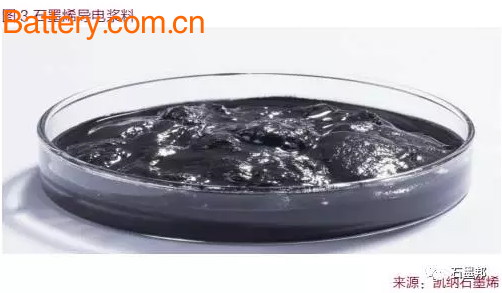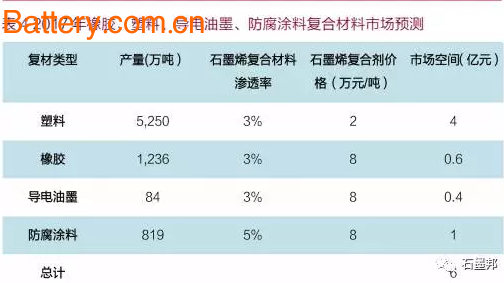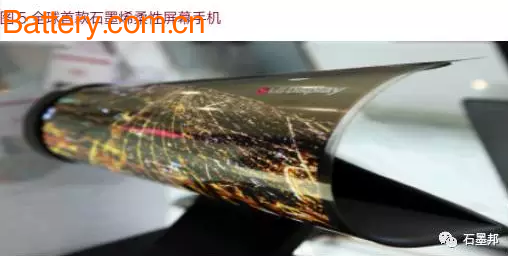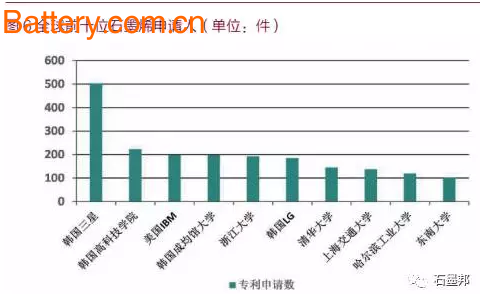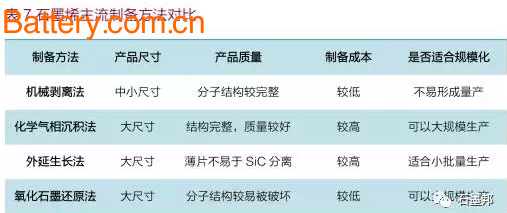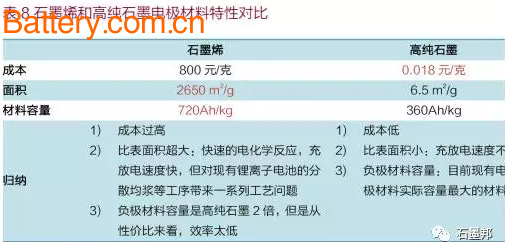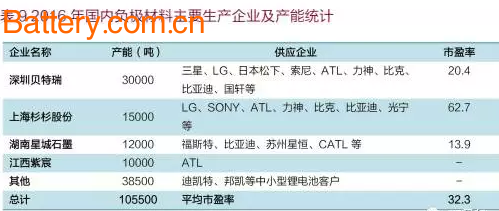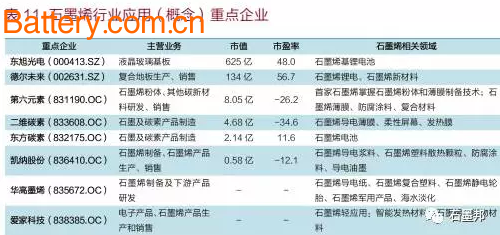China's graphene application and future trends
The global graphene industry is still in the mid-stream patent layout stage, the downstream industrial chain has not yet formed, and graphene demand is dominated by primary low-end applications and concept speculation. Together, these two points lead to the current non-mainstream applications of graphene in the global application of graphite mineral resources. Graphene as a “alternative material†still has a long way to go. 01 Why graphene has become a hot spot for new materials today Graphene has better performance in optical, mechanical and electrical fields than other materials. It has very good prospects in various fields and has a wide range of applications. Therefore, graphene has become a new field in new materials and new energy in the past two years. Hot spot. In terms of policy, in the twenty-third chapter of the “13th Five-Year Plan†announced by the state in 2016, the state has clearly defined the importance of graphene in strategic emerging industries, and graphene has entered the “13th Five-Year†catalogue as a high-end material. In addition, in the Ministry of Industry and Information Technology issued "Made in China 2025", the state has determined the development of the graphene material technology route. In the past two years, four graphene industry innovation bases have been established in China, and national leaders have also repeatedly investigated the industrialization of graphene. This shows that the country does not spare no effort in the support of the graphene industry. Under the dual drive of policy guidance and industrial upgrading, China's graphene has been applied in the primary stage. The downstream application of graphene as conductive paste and anti-corrosion coating has initially formed a scale, and has certain market development space. After investigating graphene-related companies, we found that the cost of graphene preparation and the downstream application technology of graphene are insufficient, which restricts the development of graphene to a deeper stage. Why graphene is the so-called "king of new materials" Graphene is mainly a planar crystal material having a single-layer carbon atom structure which is peeled off from flaky graphite. Unlike other graphite materials, its carbon atoms are arranged in a two-dimensional periodic honeycomb lattice. According to the classification of carbon atom layers, it can be divided into single layer graphene (single carbon atom layer), multilayer graphene (2-10 carbon atom layers) and graphene microchip (10 < carbon atom layer <100um). Single-layer graphene is currently the thinnest but hardest nanomaterial known in the world. Graphene has superior performance in optical, mechanical and electrical properties than other materials. In terms of mechanics, graphene is the strongest and highest known substance in humans, with a strength of about 180 GPa, which is 100 times that of ordinary steel. In addition, graphene also has good toughness, graphene sheets per unit area can withstand 4kg weight, and its toughness is equivalent to 20 times that of carbon fiber; In terms of thermal conductivity, graphene itself has a thermal conductivity of 5300 W/m ̇K, which is the best thermal conductive material at room temperature. The thermal conductivity is 1.51 times that of carbon nanotubes and 13 times that of copper. In terms of electricity, graphene is the best conductive material at room temperature. Due to its special band structure, the electronic motion interference at room temperature is small, and the transmission quality is greatly improved. The electrical properties of graphene are highlighted by high carrier mobility and high current density, and the carrier mobility is 15000 cm2/V ̇s, which is 10 times that of commercial silicon wafers. The current density tolerance is 200 million A/cm2, which is equivalent to 100 times that of copper. Comprehensive analysis of various properties and characteristics of graphene, graphene as a substitute material has certain advantages in the application of high-tech fields, and is also the reason why graphene is called "the king of new materials." 02 Application Status and Future Prospects of Graphene 1 Graphene application field The characteristics of graphene make it widely used. In addition to the thermal, mechanical and electrical properties described above, graphene also has several special functions such as low temperature hydrogen absorption, normal temperature without scattering, strain sensing, etc., which makes graphite. The olefin can be used to make hydrogen absorbing materials, non-scattering transmission devices, strain sensors, bipolar semiconductors, and catalysts. Comprehensive analysis of various properties of graphene, the future application will be very broad, mainly concentrated in the electronics industry and chemical industry, especially in the lithium industry, lithium battery electrodes, touch screen, super capacitor field and chemical industry coating, insurance , adsorption, desalination, etc. 2 potential outbreaks of graphene in current application fields 2.2.1 Graphene power battery industry Lithium-ion batteries are considered to be the classic energy source for modern materials and new energy sciences as new energy vehicles gradually replace the progress of internal combustion engine vehicles. However, the charge and discharge performance and energy storage performance of power batteries have always been the main obstacles restricting the development of the new energy industry. Graphene having excellent electron mobility and low resistivity properties such that as the positive and negative electrode material of lithium battery or a lithium battery positive and negative electrode conductive agent, the lithium electrode through the bad effectively improve performance, increase the charging speed and storage properties. The battery for the production of graphene as a battery electrode material is still in the experimental stage, but the research and development technology of the lithium battery electrode additive of graphene in China is relatively mature. The graphene conductive paste is used to encapsulate the positive electrode material such as lithium iron phosphate, thereby increasing the battery charging. The speed replaces the other carbon material conductive agent, and the conductivity of the electrode added with the graphene conductive agent is 10 times that of the carbon nanotube conductive agent, and 40 times that of the conductive carbon black conductive agent. At present, Chinese battery companies have tried to use graphene paste as a conductive agent, which has a certain market space. For example, BYD currently purchases about 500 tons of graphene slurry per month. With the gradual expansion of the global power lithium battery market, China's power lithium battery expansion capacity is expected to be approximately 15.2Gwh in 2017, while the domestic power lithium battery capacity will be 18.97Gwh in 15 years, and capacity expansion will be nearly 80%. 210,000 tons. Therefore, if graphene paste is used as the positive electrode coating material of power battery in 2017, accounting for 3% of the total cladding material, calculated according to 80,000 yuan per ton, the market size of graphene slurry in 2017 will reach 500 million yuan, with the power The release of lithium battery capacity and the increase of the permeability of graphene coating materials, it is expected that the market scale will maintain a growth rate of more than 100% in the next three years, and the market scale of graphene paste in electrode coating of power lithium batteries will exceed 40. If the graphene slurry replaces all the cathode coating materials in the next decade, the market size of graphene pulp will exceed 20 billion yuan. Summary, domestic graphene conductive paste as a lithium battery positive and negative electrode coating material technology is relatively mature, power battery companies have begun to use graphene slurry, with a certain market space. However, the technology of graphene materials as battery electrodes is still immature. Therefore, the potential explosion of the application of graphene combined with power lithium batteries is the application of graphene conductive agents. 2.2.2 Graphene Composites Industry The properties of graphene itself can be combined with other materials to change the characteristics of the original materials, and can give greater advantages to the original materials. â—†Rubber-plastic composite (graphene powder) Adding graphene powder to a base such as rubber or plastic can improve the electrical conductivity, thermal conductivity and toughness of the base material, and comprehensively modify the material, such as reinforced plastic, antistatic plastic, and heat conductive plastic. â—†Composite of metal, semiconductor material and polymer material (graphene ink) The graphene ink is compounded with a base material: a metal and a compound thereof, such as gold, silver, copper, aluminum, etc.; a semiconductor material such as silicon, germanium, etc.; a conductive polymer and a small molecule such as graphite. This reduces the electrical resistance of the base material, increases electrical conductivity, optical transparency, and strength and toughness. It is widely used in various conductive circuits and electronic products such as sensors, radio frequency identification systems, smart packaging, medical monitors and the like. For example, copper wire is used for the inner conductor of the national grid cable. If the aluminum wire is used as the conductor, the cost will be reduced. Combining the graphene ink with the aluminum wire will increase the conductivity and strength and toughness of the aluminum wire, thereby replacing the traditional copper wire. . â—†Anti-corrosion coating compound (graphene powder) After adding graphene to the anti-corrosion coating, the graphene can form a stable conductive grid, effectively improving the utilization rate of the zinc powder. From the practical point of view, adding about 5% of graphene powder can reduce the amount of zinc powder used by 50%. At the same time, the graphene coating can form a physical barrier layer between the metal surface and the active medium, and has a good protective effect on the substrate material. China's graphene composite anti-corrosion coating technology has been very mature. In 2015, this technology has been applied to the anti-corrosion of offshore wind power towers. Graphene composite anti-corrosion coating can resist corrosion for up to 125 days, which is three times that of ordinary heavy-duty anti-corrosion coatings, and zinc. The amount of powder used is one-third that of ordinary heavy-duty coatings. In the future, graphene will have a broader market space in the petrochemical industry and the power industry, such as construction, ships, railways, bridge terminals, containers and other anti-corrosion coatings. Summary, China's graphene application technology in composite materials has been relatively mature, the base material is modified by the combination with graphene, showing better performance. Graphene composite technology has been applied to it. It is expected that its application in rubber, semi-/conductive materials and anti-corrosion coatings will reach 600 million yuan in 2017. However, with the increase in the permeability of graphene and the amount of graphene used in composite materials, the market for graphene composites is expected to exceed 5 billion yuan in the next three years. Therefore, graphene composites are recently graphene. A potential outbreak of industrialization. 3 prospects for potential applications of graphene 2.3.1 Graphene touch screen application Graphene touch screen products have been released, which will partially replace the ITO touch screen. The touch products in the current market are mainly ITO (Indium Tin Oxide). However, compared with the graphene touch screen, the performance is better, and it has two characteristics of flexibility and wide temperature adaptability. At present, graphene touch screens have been successfully developed and put into production at home and abroad. South Korea's Samsung and Chengdu University have researched and manufactured 63 cm wide pure graphene, and made flexible touch screens with the graphene. Both the carbon and the sixth element have mass production of sensors and touch components. The touch screen market is huge, and graphene touch demand is expected to grow rapidly. The global touch screen market is huge. The scale of China's touch screen has increased from 800 million in 2013 to 1.2 billion in 2015. It is expected that the production volume will reach 2 billion in 2017. At present, the technology of graphene touch screen has been relatively mature. In 2016, the first graphene mobile phone developed by China was introduced, which can be bent freely, which not only solves the problem of rigid and fragile of traditional mobile phone ITO screen, but also has good transparency of graphene. The display is also sharper than the traditional ITO screen, and weighs only 200 grams. However, the current production cost of graphene is one of the factors that restrict the development of this technology. Therefore, as the industrial production cost of graphene is further reduced, and the demand for flexible screens and application scenarios are improved, graphene touch components may replace all existing traditional ITO touch screens in the future, and it is expected to reach more than 100 billion in the future. Market space. 2.3.2 Graphene supercapacitors Supercapacitor is a kind of energy storage and power compensation device, which has broad application prospects in the fields of hybrid power, mobile communication, emergency power supply, and defense technology. Electrode materials are a key part of their production, accounting for about 40% of the total capacitor production cost. Currently, the most widely used supercapacitor electrode materials are carbon materials, including activated carbon and carbon nanotubes. Among them, the internal pore structure control of activated carbon is difficult, the specific surface area utilization rate is low, and the electrochemical performance is unstable. Secondly, the price of carbon nanotubes is relatively expensive (400 yuan/g), and it is difficult to purify, thereby greatly affecting carbon nanotubes. Practical application in supercapacitors; graphene is a new type of carbon material with high conductivity, large specific surface area, stable chemical structure, and more effective surface release, which is conducive to electron penetration and transportation. The scale production and cost reduction of olefins are more suitable as supercapacitor electrode materials than other carbon electrode materials. China's traditional supercapacitor market is huge. Even if graphene capacitors account for only 10% of them in the future, it is expected that the market scale of graphene powder for graphene supercapacitor electrodes will exceed 1 billion yuan in the future. In 2014, China has been able to produce graphene supercapacitors, which have a storage capacity of 3,000 Farads. In 2016, China launched a supercapacitor bus that takes only 3 minutes per charge and can travel up to 20 kilometers. Due to the short storage time and fast discharge, the use of supercapacitors in the direction of the power battery is not a stable product. If the energy density of supercapacitors can be solved, supercapacitors will be able to replace all the power batteries on the market. Graphene supercapacitors will be at least a tens of billions of market size. 2.3.3 Other future applications â—†Biomedicine Graphite-dilute quantum dots have good biocompatibility and good optical properties, and can be widely used in biomedical fields such as cell imaging, nano drug transportation systems, biological detection, biological imaging, tumor treatment, and biosensors. â—† wearable device At present, wearable devices have fatal defects in adapting the human body structure, and flexible display screens and raw materials that cannot be bent and freely stretched are not applied thereto, which will limit the use of smart wearable devices. Graphene is transparent, flexible, and has high electrical conductivity and can be arbitrarily changed. It can be applied to wearable devices to better adapt to the human body and achieve consumption breakthrough. Currently, technically, graphene flexible screens have achieved breakthroughs. If the flexible raw materials are broken, graphene will be better adapted to wearable devices in the future. Development bottleneck of graphene application in China The application technology of graphene materials is not mature at this stage At present, the downstream industrial chain of graphene has not yet been formed, and the world is still in the pre-patent layout period of graphene. The patented graphene technology in China has certain speciality compared with other active countries. Among the number of major priority patent applications in the world, China, South Korea and the United States ranked in the top three, with 6,741, 2892 and 2,632 respectively. Among the top ten graphene applicants in the world, China's research institutions account for 5, all of which are Chinese universities, but the first, third and sixth patent applicants are large multinational companies in Korea and the United States. Therefore, it can be seen that the research results of China's graphene are more in the hands of colleges and universities. Only one or two enterprises have advantages. The main role of enterprises in the research and development of graphene needs to be further strengthened to promote the commercialization of technology. Through the observation of the top ten applicants, foreign universities and enterprises have mastered a large number of core patents at the same time. The patent layout of American and Korean companies is more inclined to the industrial application of graphene, playing an important role in the process of graphene industrialization. On the other hand, from the type analysis of patents, although the number of graphene patents in China is the world's leading, most of the patents are carried out around the graphene preparation method, and the layout of graphene applications is relatively small. The nature of the patent applicant and the layout of the patent type are factors that restrict the commercialization of the downstream application technology of graphene in China, and also restrict the development of the overall application of graphene. Graphene scale production is too expensive With the world's graphene research boom attracting the attention of domestic and foreign preparation scientists, there are more than ten kinds of graphene preparation methods in ten years, but mechanical stripping, chemical vapor deposition (CVD), epitaxial growth and graphite oxide reduction. Four are the current mainstream methods for graphene preparation. These four methods have their own advantages and disadvantages, and the preparation costs are also different. According to the investigation of upstream enterprises in graphene, the methods for preparing high-quality graphene in China are: mechanical stripping method and vapor phase deposition method. The mechanical stripping method is mainly a method for preparing graphene powder. Although the cost is low, the controllability is poor, and mass production is difficult. The price of the single-layer graphene powder obtained by the method is currently between 800 and 1000 yuan/g; Chemical vapor deposition is the main method for obtaining graphene film, and it is the most promising method for large-scale production of large-sized graphene. However, its complicated process, high energy consumption and high value of preparation equipment lead to an increase in production cost. The single-layer graphene film prepared by the CVD method is priced between 600 and 800 yuan/g. Such high material costs limit the application of high-quality graphene materials, and only the economical strength of graphene downstream enterprises can be used, and it is difficult to transform from graphene primary applications to large-scale promotion applications. Therefore, at present, graphene micro-sheets are mostly used for graphene, which requires only about 20 yuan per gram. Although the cost has a significant advantage over high-quality graphene, its performance still cannot achieve the most ideal effect, so it can only meet Middle and low end applications of graphene. The high cost of preparation leads to a high level of high-quality graphene material prices, which is one of the reasons for limiting its large-scale application, and the alternatives are cheaper, so high-purity graphite is more used in the market. Alternatives still do not end "historical mission" The use of graphene in new energy sources has always been the most concerned issue in the industry. "Graphene batteries" are often associated with super batteries. However, due to the external factors such as process, cost and other factors, the “graphene battery†is often more practical than the utility. Therefore, high-purity graphite is still the mainstream application of high-end industrialization of graphite resources. It has similar properties to graphene, and has good thermal conductivity, temperature resistance, self-lubricity, conductivity, thermal shock resistance and corrosion resistance. Sex and other properties, widely used in metallurgy, chemical, aerospace, electronics, machinery, nuclear energy and other industrial fields. At present, the main applications of high-purity graphite in the market are: battery anode materials for the battery industry, advanced refractory materials and coatings for the metallurgical industry, and conductive agents for the electrical industry. Moreover, high-purity graphite in the market has not only stayed at the level of 99.9% carbon content, but high-purity graphite with 99.99% and 99.999% carbon content has been able to achieve large-scale production and meet the needs of higher-end applications. From the above table, it can be analyzed that graphene is full of difficulties in replacing high-purity graphite in the field of new energy batteries. First, graphene batteries and electrodes are currently too costly, and the price is difficult to generalize to ordinary users; Second, the technology of the battery and electrode manufacturer can't satisfy the disperse homogenization of lithium-ion battery in the large surface area of ​​graphene. At this time, there is no sufficient profit margin driven by the breakthrough of performance index, so this will be a A huge project. Third, graphene is tens of thousands of times the cost of high-purity graphite, but its theoretical capacity is only twice that of the latter, and its cost performance and efficiency are very low. Finally, the energy density of graphene as an energy storage material is very low, which results in a very fast charge and discharge rate, but the energy storage duration is only one tenth of that of ordinary lithium batteries . At present, the "graphene battery" on the market is only a battery with a graphene material added to the electrode. As a "substitute", high-purity graphite has not yet completed the "historical mission" on the basis of the existing technology. In 2015, the total output of high-purity graphite in China was about 60,000 tons. Wherein the high purity graphite as a negative electrode material for a lithium battery which accounted for more than 25% of the size of the overall application. China is the world's leading producer of lithium battery anode materials. Chinese companies Shenzhen Betray and Shanghai Shanshan Co., Ltd. account for 37% of the global anode material production scale. At the same time, high-performance and high-power battery preparation technology is China. The key to the development of new energy vehicles, the total output of China's new energy power battery anode materials in 2015 was 72,800 tons, of which advanced anode materials made of high-purity graphite accounted for 20.6%, and the remaining 79.4% were low-order graphite and other carbon. Prime material. This shows that high-purity graphite can meet the needs of current high-performance and high-power battery preparation technology, and is gradually replacing other anode materials. As the current production scale of carbon material electrode materials will continue to expand with the development of high-tech fields in new energy vehicles, the capacity of China's new energy battery anode materials key enterprises will further increase in 2016, so high-purity graphite in battery anode materials Applications still have room for development, and it is estimated that in the next two years, the proportion of high-purity graphite in the anode material will exceed 50%. At the same time, the recovery and rapid development of strategic emerging industries such as photovoltaics and nuclear power in the electrical industry, the application of high-purity graphite as a conductive agent and silicon crystal growth equipment may exceed expectations in the future. Large-scale high-quality high-purity graphite, as an alternative material, has a wide application space and prospects with the development of high-tech and new technologies. Summary, at present, China's graphene is limited by the technical disadvantages of application and the high cost of preparation. These two points also cause graphene to encounter obstacles in replacing other materials. High-quality, high-purity graphite is more important as an important alternative to high-tech and strategic emerging industries, so the demand for high-quality, high-purity graphite is expected to be released in the next two years. However, at present, the main production process of high-purity graphite “acid-base method†consumes a lot of energy and the wastewater is seriously polluted. Therefore, high-purity graphite application is not the best choice in an environment-friendly society. Application and market analysis of graphene in China Status of application of graphene in China At present, the global focus on graphene performance is mainly focused on its excellent optoelectronic properties. China and other key graphene research countries have set long-term development goals, and the application of graphene industrialization is divided into three stages. Graphene has different key application areas in different stages of industrialization. The first stage is mainly the industrialization of low-end graphene materials. At this time, the graphene preparation technology is becoming more and more mature, the downstream demand of graphene is gradually opening, the mass production of graphene and the replacement of graphene materials with traditional materials are in progress. With the opening of the downstream application market and the maturity of high-end graphene materials research technology, the characteristics of graphene as a high-quality material will be more fully explored, and industrialization will gradually enter the second stage. There are continuous technological breakthroughs in the preparation and application of graphene, mainly focusing on the preparation and application of graphene films. Through the continuous maturity of the first two stages of application, high-end graphene preparation technology has become popular, downstream demand will be more intense, and graphene industrialization will enter the third stage. This stage will allow the graphene application to truly penetrate the average user, whether it is a flexible screen phone or a human bio device. At present, China's patented graphene raw materials, production, sales volume and graphene are the first in the world. Therefore, China has an absolute advantage in developing graphite applications. China's graphite mineral reserves are 2 billion tons, accounting for 72% of the world's total reserves of graphite mineral resources, accounting for 80% of the global total. In addition, China's graphene patents remove patents related to graphene preparation. Graphene patents are mainly concentrated in the field of energy storage devices and composite materials in the electronics industry, accounting for 73.5% of the total. At the same time, the national policy level has also planned a specific path for the development of graphene in the next decade through "Made in China 2025". In 2016, China's first single-layer graphene mass production base was settled in Xiamen, and it is planned to achieve industrial production of high-quality graphene by 2020. The advent of graphene electronic paper, flexible screen and graphene mobile phone indicates that China's graphene has entered the first stage of graphene industrialization. In summary, most of the world's key countries are still in the first stage of the application of graphene industrialization, and China has entered this stage with its resources and patent advantages. Combining the needs of China's graphene downstream enterprises and the characteristics of China's graphene patents, the most promising and most advantageous graphene industrialization application field in China is the field of electronic energy storage devices and graphene composite materials. The application in other fields is patented. Restrictions also require the development of graphene midstream research to continue deep cultivation. At present, the world is still in the period of graphene patent layout, and it is normal for the downstream application to be insufficient. Although China ranks first in the world in the number of graphene patents, the layout of corporate participants and graphene application technology needs to be strengthened. Although domestic enterprises are actively responding to national policies, the downstream industrial chain of graphene has not yet formed, and domestic graphene applications are in the first stage. With the influence of national policy orientation, the basic application of graphene will gradually promote industrial application, which will help the development of China's graphene industry in the deeper stage. Graphene industry application (concept) key enterprise analysis Graphene is recognized as the “king of new materialsâ€, and there are many downstream application scenarios. Under the influence of the “13th Five-Year Plan†policy, related companies are based on the main business or expand graphene related research or existing research results. Used in traditional products. Our main listed company, Dongxu Optoelectronics and Del Future, is a representative company of non-graphite related main business to expand graphene research. Through the fermentation of the graphene concept, it has excellent performance in the secondary market, but the practical application of its graphene products has yet to be tested by the market. In addition, comparing the other six new three-board companies of the two companies listed on the main board is more worthy of attention in the development of downstream applications of graphene. Because of the fact that both the graphene preparation technology and the practical application of graphene products, the six companies of the new three boards have different advantages. For example, the sixth element together with wind power equipment and coatings companies established Dao Peng Technology and built a 50,000-ton graphene anti-corrosion coating production line, which shows that the application of graphene products in the vertical field has been recognized by downstream companies. Through the comparison of the financial data of the key graphene enterprises, the new three-board enterprises, which rely solely on graphene as the main business, generally have lower market value and weaker profitability, and the return on net assets is negative. The reason is that the fixed cost investment in the early stage of the enterprise is large, and the development of the graphene industry is in the initial stage, the industrial chain has not yet fully formed, and the labor and sales costs and sales revenues are “upside downâ€. Therefore, the enterprises in the industry are basically in a state of loss. From the aspect of price-earnings ratio, although the graphene concept has been fiery in the past two years, the price-earnings ratio of the three-plate graphene enterprises is still low compared with the main board enterprises, which leads to the fact that the actual value of graphene downstream applications has not yet been highlighted. to sum up Graphene is outstanding in the fields of mechanics, thermals, optics and electricity, but it is affected by the preparation technology, and the cost of high-quality graphene is high. In addition, the global graphene industry is still in the mid-stream patent layout stage, the downstream industrial chain has not yet formed, and graphene demand is dominated by primary low-end applications and concept speculation. Together, these two points lead to the current non-mainstream applications of graphene in the global application of graphite mineral resources. Graphene as a “alternative material†still has a long way to go. With the in-depth study of graphene in the world and the continuous investment of graphene industry in key countries, key countries and China have started from the low-end application of graphene and entered the first stage of graphene industrialization application. China has achieved industrial application in many industrial fields: lithium battery electrode conductive agent field and graphene composite material field. At the same time, China's level is also the world's leading position in these two aspects. Regardless of China's influence on global graphene research, it has a positive role in the further application of graphene technology. In addition, the potential application of graphene in the future is full of imagination, and the self-developed graphene flexible screen and supercapacitor products have emerged. If the bottleneck problem is broken over time, it is a subversive change for the alternative traditional industry, so the market space is even larger. It is expected that the total market size of graphene in various fields will be at least one hundred billion level in the next 10 years. Market. It can be seen that China has a certain market development space in the first stage of graphene application, and the potential development application technology of graphene is full of imagination space and larger market space. With the development of downstream application technology, the global demand for graphene will increase year by year. Graphite as a non-renewable resource, Chinese enterprises should properly control the barbaric mining of graphite, and should produce high-quality graphene to increase the added value of products and increase China. The competitiveness of graphene products in the global graphene market. In summary, graphene has been able to achieve low-end industrial applications, and further industrialization applications in the future, although the imagination is large, but still need to wait for the graphene industry to further mature. Fast, high,cleaner,multifunctional Ningbo Norjia Bell Electric Appliance Co., ltd , https://www.norjiabell.com

